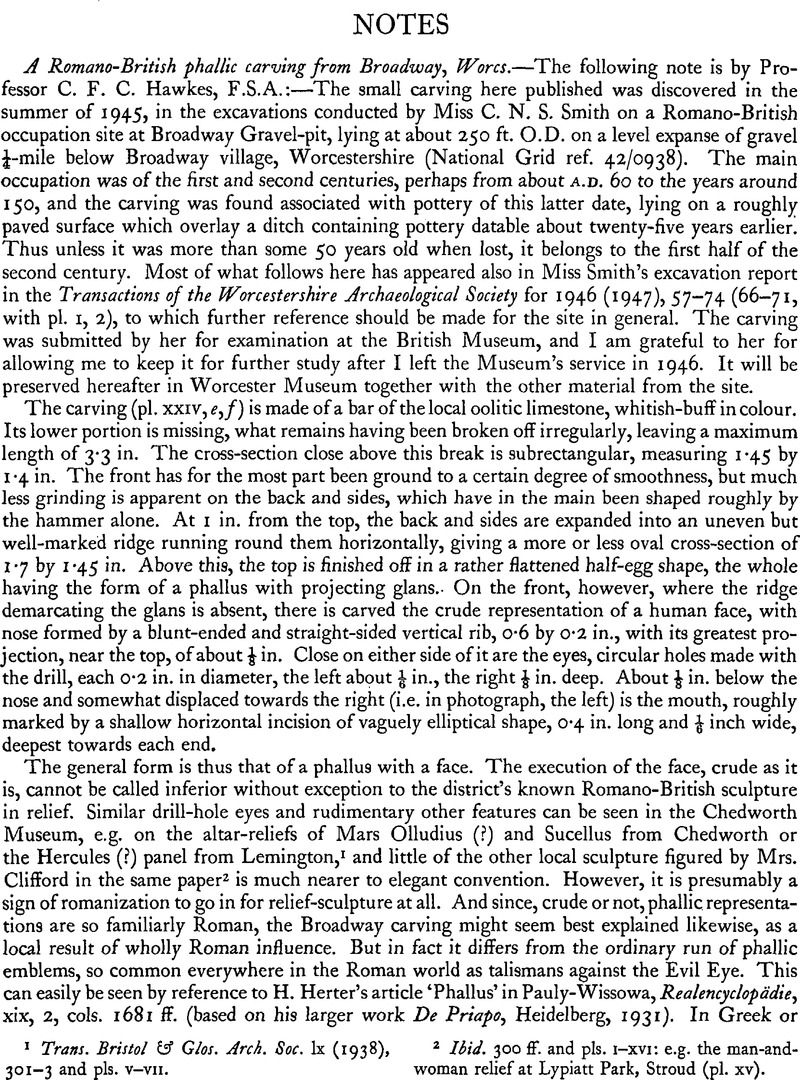No CrossRef data available.
Article contents
A Romano-British phallic carving from Broadway, Worcs.
Published online by Cambridge University Press: 08 January 2012
Abstract

- Type
- Notes
- Information
- Copyright
- Copyright © The Society of Antiquaries of London 1948
References
page 166 note 1 Trans. Bristol ∧ Glos. Arch. Soc. lx (1938), 301–3 and pls. v–vn.
page 166 note 2 Ibid. 300 ff. and pls. I–XVI: e.g. the man-and-woman relief at Lypiatt Park, Stroud (pl. xv).
page 167 note 1 Corpus Vasorum Antiquorum, France, iii, pl. 18, 20 (detail, pl. 30, I).
page 167 note 2 Jacobsthal, P., Early Celtic Art (Oxford, 1944)Google Scholar, Text, 8–10, 165–6, nos. 11, 12; pls. 9–12, 218.
page 167 note 3 Op. cit., Text, 2–3; pl. 217, a.
page 167 note 4 Ibid.: if the Niederschönhausen fibula, Jacobs-thal's no. 308 (Text, 193–4; pl. 157), perhaps shows an ithyphallic figure, this is an isolated case, and one within the range of the same southern influence.
page 167 note 5 Antiq. Journ. xviii, 391 ff.; pl. LXXVII, no. 8.
page 167 note 6 Henry, Françoise, Irish Art (1940), 2–5Google Scholar, with pl. 2 (where a, ‘St. Goar’, is in fact the Pfalzheim stone, which till 1934 was kept at St. Goar. It is now in the Provinzialmuseum collections at Bonn).
page 167 note 7 Op. cit. 3; Déchelette, Manuel (2nd ed.), iv, 1029, fig. 700, 2 (cf. 1, the Turoe stone); P. Du Chatellier, Les Époques préhistoriques dans le Finistère, 322, pl. xxx: the stone is now, with all the Du Chatellier collection, in the National Museum at St. Germain. It is 87 cm. high.
page 168 note 1 Marsille, L. in Bull. soc. polymathique du Morbihan, 1912Google Scholar, and ‘L'Âge du fer dans le Morbihan', Ibid. 1923. See also Antiq. Journ. xiv, 61, for one from Kerhilio, Erdeven (Morbihan), found ‘in La Tène surroundings’ by Zacharie Le Rouzic. For baetyls also in Portugal, see E. Cartailhac, Les Âges préhistoriques de l'Espagne et du Portugal, 136.
page 168 note 2 Antiq. Journ. xiv, 59–61.
page 168 note 3 A fragment of what Smith believed might be another, about 3.6 in. in diameter, was found in 1937 at Little Witcombe, close to Barnwood, in a group of relics now in Mrs. Clifford's possession and kindly shown to me by her, from an apparently ancient bog-deposit, containing, as Mrs. E. M. Megaw has been good enough to report, fen or forest peat: these comprise worked flints and quartzite pebbles, animal bones and teeth, two pieces of human skull with incised markings, and two flat sherds of hard, brownish, pitted coarse pottery, seemingly not older than the Iron Age. The fragment is of conglomerate, and might be from a rotary quern, but the diameter seems curiously small.
page 168 note 4 Mrs. Clifford has kindly supplied the following references: O. G. S. Crawford, The Long Barrows of the Cotswolds, 69 (Belas Knap); 85 (Bown Hill); 104 (Uley: including secondary burial; cf. Proc. Prehist. Soc. IV (1938), 192Google Scholar, n. 1); 131 (Randwick); 142, and Proc. Prehist. Soc. VI (1940), 136Google Scholar (Rodmarton); Ibid. iv (1938), 192 (Nympsfield); Archaeologia, LXXXVI (1936), 123Google Scholar, 149–50 (Notgrove); Journ. Anthr. Inst. V (1875), 145Google Scholar (Cow Common).
page 168 note 5 And conceivably also at King's Stanley, Bisley Church, Kingsholm, and Cirencester: see Mrs. Clifford in Trans. Bristol & Glos. Arch. Soc. LX (1939), 297–307.Google Scholar
page 168 note 6 Archaeologia Aeliana, 4th sei., XII (1935), 187–94.Google Scholar I am much indebted to Dr. Heichelheim for examining the Broadway carving with me in the British Museum in 1946, and for his opinions expressed in subsequent correspondence.
page 169 note 1 Op. cit. 188, no. 3 (now lost).
page 169 note 2 Certainly two: the right hand of the third had apparently been broken off.
page 169 note 3 Op. cit. 191–3, nos. 14–16, and the Gallo-Roman hooded-dwarf phallic lamp-figures, nos. 19–28.
page 169 note 4 Op. cit. 188, no. 4.
page 169 note 5 Petrie, W. M. Flinders in The Hill-Figures of England (1926)Google Scholar, with Antiquity, III (1929), 277Google Scholar ff. (O. G. S. Crawford); vi (1932), 214–16 (Stuart Piggott); on Wandlebury and in general also, Heichelheim, F. M. in Camb. Antiq. Soc. Proc. XXVII (1937), 53–9Google Scholar—pages which might well be better known.




